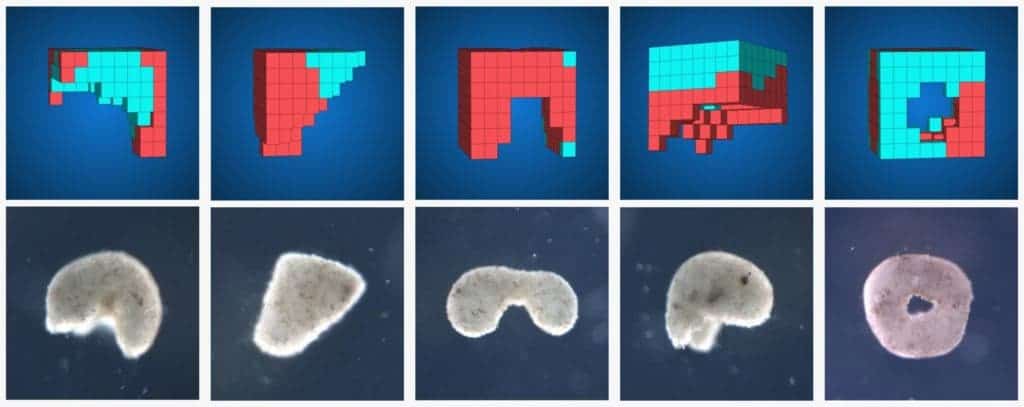Researchers at the University of Vermont have repurposed living cells into entirely new life-forms — which they call “xenobots”.

Image credits Douglas Blackiston / Tufts University.
These “living machines” are built from frog embryo cells that have been repurposed, ‘welded’ together into body forms never seen in nature. The millimeter-wide xenobots are also fully-functional: they can move, perform tasks such as carrying objects and healing themselves after sustaining damage.
This is the first time anyone “designs completely biological machines from the ground up,” the team writes in their new study.
It’s alive!
“These are novel living machines,” says Joshua Bongard, a professor in UVM’s Department of Computer Science and Complex Systems Center and co-lead author of the study. “They’re neither a traditional robot nor a known species of animal. It’s a new class of artifact: a living, programmable organism.”
“It’s a step toward using computer-designed organisms for intelligent drug delivery.”
The xenobots were designed with the Deep Green supercomputer cluster at UVM using an evolutionary algorithm to create thousands of candidate body forms. The researchers, led by doctoral student Sam Kriegman, the paper’s lead author, would assign the computer certain tasks for the design — such as achieving locomotion in one direction — and the computer would reassemble a few hundred simulated cells into different body shapes to achieve that goal. The software had a basic set of rules regarding what the cells could and couldn’t do and tested each design against these parameters. After a hundred runs of the algorithm, the team selected the most promising of the successful designs and set about building them.
Image credits Sam Kriegman, Douglas Blackiston, Michael Levin, Josh Bongard, (2020), PNAS.
This task was handled by a team of researchers at Tufts University led by co-lead author Michael Levin, who directs the Center for Regenerative and Developmental Biology at Tufts. First, they gathered and incubated stem cells from embryos of African frogs (Xenopus laevis, hence the name “xenobots”). Finally, these cells were cut and joined together under a microscope in a close approximation of the computer-generated designs.
The team reports that the cells began working together after ‘assembly’. They developed a passive skin-like layer and synchronized the contractions of their (heart) muscle cells to achieve motion. The xenobots were able to move in a coherent fashion up to days or weeks at a time, the team found, powered by embryonic energy stores.
Later tests showed that groups of xenobots would move around in circles, pushing pellets into a central location, spontaneously and collectively. Some of the xenobots were designed with a hole through the center to reduce drag but the team was able to repurpose it so that the bots could carry an object.
It’s still alive… but on its back?

Image credits Douglas Blackiston / Tufts University.
One of the most fascinating parts of this already-fascinating work, for me, is the resilience of these xenobots.
“The downside of living tissue is that it’s weak and it degrades,” says Bongard. “That’s why we use steel. But organisms have 4.5 billion years of practice at regenerating themselves and going on for decades. We slice [a xenobot] almost in half and it stitches itself back up and keeps going. This is something you can’t do with typical machines.”
“These xenobots are fully biodegradable,” he adds, “when they’re done with their job after seven days, they’re just dead skin cells.”
However, none of the team’s designs was able to turn itself over when flipped on its back. It’s an almost comical little Achilles’ Heel for such capable biomachines.
Image credits Sam Kriegman, Douglas Blackiston, Michael Levin, Josh Bongard, (2020), PNAS.
Still, they have a lot to teach us about how cells communicate and connect, the team writes.
“The big question in biology is to understand the algorithms that determine form and function,” says Levin. “The genome encodes proteins, but transformative applications await our discovery of how that hardware enables cells to cooperate toward making functional anatomies under very different conditions.”
“[Living cells] run on DNA-specified hardware,” he adds, “and these processes are reconfigurable, enabling novel living forms.”
Levin says that being fearful of what complex biological manipulations can bring about is “not unreasonable”, and are very likely going to result in at least some “unintended consequences”, but explains that the current research aims to get a handle on such consequences. The findings are also applicable to other areas of science and technologies were complex systems arise from simple units, he explains, such as the self-driving cars and autonomous systems that will increasingly shape the human experience.
“If humanity is going to survive into the future, we need to better understand how complex properties, somehow, emerge from simple rules,” says Levin. “If you wanted an anthill with two chimneys instead of one, how do you modify the ants? We’d have no idea.”
“I think it’s an absolute necessity for society going forward to get a better handle on systems where the outcome is very complex. A first step towards doing that is to explore: how do living systems decide what an overall behavior should be and how do we manipulate the pieces to get the behaviors we want?”
The paper “A scalable pipeline for designing reconfigurable organisms” has been published in the journal PNAS.



